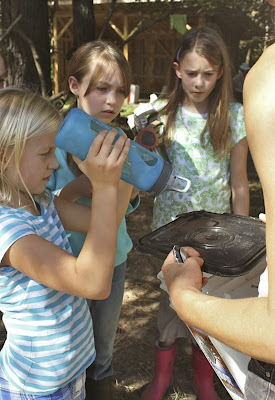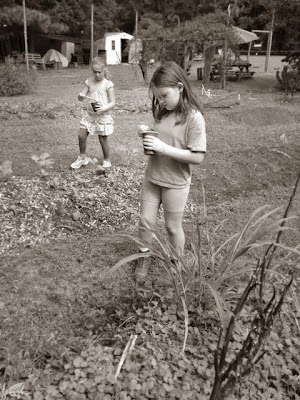Thank you very much to Rula Mouawad for taking the photos in this sampling of what third grade has been up to since school started this fall. Enjoy!
First a view of some of the work we've done in the garden this fall:
Third grade dad, Dave Swanson, loaned us his broad fork so that the students would be better equipped to prepare beds for planting. A broad fork is a wide, heavy "fork" that can be used to loosen up soil deep down. This group is working the soil for a garlic bed.
Once a bed is thoroughly weeded and the soil loosened deep down, we sift some of the compost we spend all year making. Our compost is made from the food scraps 3rd grade brings down each week in compost buckets from all of the classrooms (including high school and kindergarten), from chicken, bunny and horse manure collected at the farm, from weeds we dig up in the garden and from donations of old, indedible hay given to us by area horse barns.

When a bed is completely ready, we plant either seeds or transplants. Mahea, Michael and Shiva are transplanting lettuce here. So far this year our garden grows sorrel, broccoli, nasturtium, evening primrose, mums, thyme, kale, spinach, chives, shiitake, lettuce, arugula, collards, chard, daikon, carrots, onions, beets, radishes, peas, oats and wheat. We'll soon be planting rye and garlic as well. In mid November planting season ends and we switch our activities to maintenance chores around the farm and doing what we can to protect our crops from cold weather while they overwinter.
The children learn that bug life in the garden is both welcome and necessary to the health of our garden. Early on they learn that there are 5 main types of bug:
- flesh munchers (horseflies, mosquitoes, ticks, etc.)
- plant munchers (squash bugs, japanese beetles, aphids, etc.)
- scavengers (earthworms, pillbugs, crickets, daddy long legs, etc.)
- pollinators (butterflies, bees, some wasps, etc.)
- hunters (spiders, praying mantis, assassin bugs, ladybugs, etc.)
In Biodynamic gardening we try to maintain a balance amongst all these types of insects that is most favorable to our plants. A few flesh and plant munchers are OK in the garden because we know that they are a vital part of the web of life. When we get a lot of them, then we try to figure out why and change the environment to keep them from spreading or coming back so easily next year. Another thing we do regularly is sprinkle or spray two kinds of
preparation on the plants and around the garden
to improve the health and vitality of the plants:
- stinging nettle tea, made by soaking stinging nettle for 24 hours in rain water
- milk and honey prep, made by stirring milk, local honey and rain water for 20 minutes
The nettle tea provides deep nourishment to the plants, strengthening their vitality and helping them to be a little less tasty and tempting to plant munchers. The milk and honey encourages hunters and pollinators to visit the garden and stick around. Below are pictures of Enid, Michael and Shiva spreading the milk and honey prep by sprinkling it over everything with paint brushes.
At the end of every productive day at the garden, the children have time to just enjoy their surroundings.
Below are some pictures of some of the things they get up to in their free time.
Picking the first persimmons of the season.
Khadija, Eva Grey and Anastasia give the persimmons a try.
Garret, Grey and Theon enjoy wheelbarrow rides.
Everyone loves visiting Finnigan the horse.
We also find a lot of really neat things in nature:
Fuzzy white caterpillars
Spiders who carry their babies on their back
Interesting mushrooms
A watermelon that unexpectedly grew straight out of the compost pile
A beautiful
sun dog appeared near the end of class one day.

































































